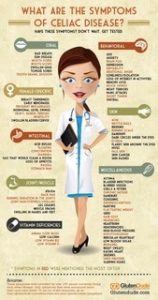May is Celiac Awareness Month
in The Too Busy to Diet Blog on May 31, 2017
 Celiac Awareness Month
Celiac Awareness Month
“The prevalence of celiac disease is rising at an alarming rate. Current trends show this condition is doubling every 15-20 years.” says Jacqueline King, Registered Dietitian Nutritionist and Illinois Academy of Nutrition and Dietetics Media Spokesperson. “And the worst part is that over 90% of individuals go undiagnosed.” It has become critical for doctors to screen their patients for symptoms that could be related to undiagnosed celiac disease. These include digestive symptoms like diarrhea, constipation, bloating, abdominal pain and gas, but can also include headaches, brain fog, iron deficiency, muscle cramps and skin rashes. A simple blood test is the first step in diagnosing, followed by an EGD or small bowel biopsy to confirm the diagnosis. It’s important to raise awareness about the condition and spread the word on the facts surrounding celiac disease.
1. It’s an autoimmune disease. Celiac disease runs in the same family as multiple sclerosis, lupus, Type 1 diabetes and rheumatoid arthritis. In those with celiac disease, the body responds to the foreign invader (gluten), by attacking the lining of the small intestine. Just having celiac disease puts one at a higher risk of developing other autoimmune diseases.
2. The cause is unknown. Many theories exist, but the true cause of celiac disease is not known. Most researchers feel that the changes in gut bacteria paired with the exposure to gluten, may trigger the condition.
3. The gluten free diet is the only treatment. By removing the foreign invader (gluten), the body stops attacking itself and allows the digestive system to heal. There are currently no over the counter medications or enzymes that can be taken to help digest gluten in the celiac population.
4. First degree relatives are at a greater risk of developing the disease. Since celiac disease is a genetic condition, there is a 1 in 22 chance in first degree relatives developing the condition at some point in their lifetime. This is a far greater chance than a healthy individual has, which is only 1 in 131.
5. Medications can contain gluten. Gluten exists not only in food, but in some medications. Look up the gluten free status of all prescription and over the counter medications on glutenfreedrugs.com or call the company.
6. Most cross contamination happens away from the home. When there is less control how food is prepared, the chances of gluten cross contamination increases. Always call ahead as well as tell the restaurant staff that you have celiac disease (or to them it may be better known as a gluten “allergy”). Many restaurants have protocols in place that they follow for these circumstances.
For more free info and tip sheets on Celiac Disease, visit celiac.org or cureceliacdisease.org. For gluten free recipes visit, glutenfreeliving.com/recipes or savorypalate.com.
#####
Buy the Too Busy to Diet book
Get your copy of the definitive diet reference guide and healthy eating book today. Stop reading those misleading fad diet books and read an easy to follow book on how to lose weight and keep it off from actual Registered Dietitians.

Recent Posts
- Barbeque Turkey Meatloaf
- Pescado a la Veracruzana
- Juicy Pork Chops
- Rotasserie Chicken Casserole
- Grilled Salmon & Blueberry Salad